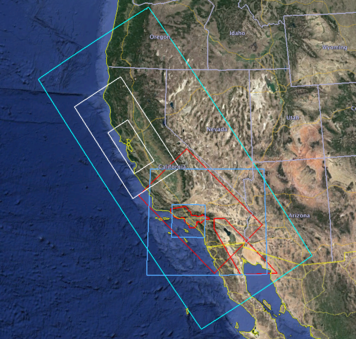UCVM
The Unified Community Velocity Model (UCVM) software framework is a collection of software tools for scientists and engineers interested in using several currently available California 3D seismic velocity models. One important use of UCVM is in high resolution 3D wave propagation simulations for California. UCVM development is an interdisciplinary research collaboration involving geoscientists and computer scientists. UCVM geoscience research includes identification and assembly of existing California velocity models into a state-wide model and improvements to existing velocity models. UCVM computer science research includes definition of a easy-to-use CVM query interface, integration of regional 3D and geotechnical models, and automated CVM evaluation processing capabilities.
Contents
UCVM Introduction
The Unified Community Velocity Model (UCVM) software is open-source scientific software designed to support earth scientists, civil engineers, and other groups interested in detailed information about earth properties. UCVM is primarily used by scientists to work with earth material properties on regional scales.
UCVM software provides a software interface to one or more existing earth structure models. Researchers may choose to use the UCVM software, in order to access one or more UCVM specific capabilities, which include:
- Provides standard query interface to multiple CVM models with different projections.
- Converts query by elevation to query by depth to create comparable models.
- Provides standard methods for tri-linear interpolation, Vs30, and basin query from models.
- Provides plotting and analysis tools that make vertical profile, horizontal, and cross section plots.
- Provides tools to add geotechnical layers and small scale heterogeneities into models.
- Supports tiling of models and background models.
- Make AWP and ETree format meshes including parallel extractions.
Current UCVM Software Releases
As of August 2017, the current version of UCVM is the C language version of the code tagged UCVM v17.1.0 (or ucvm-17.1.0). This distribution is revised version of the UCVM v15.10.0 (ucvm-15.10.0) software release. If you are installing UCVM for the first time on a Linux computer, we recommend using UCVM v17.1.0 because it includes all available updates, and is easier to install. UCVM v17.1 is a C-language implementation of UCVM that can be compiled using GNU C programming tools. The UCVM v17.1 release removes some features from the previous version so the code is simplified and more maintainable. UCVM target computing environment is Linux because of important application of UCVM on large parallel computers. It is possible to run UCVM on a Mac using a Virtual box image.
UCVM is distributed as open-source scientific software. It can be installed compiled and run on most Linux-based computer systems if the system includes software development tools including Python, C, and Fortran compilers, and other software tools. The UCVM v17.1.0 source code is distributed using a github repository including the source code, installation directions for Linux, and a wiki that provide examples and the expected results from UCVM.
- UCVM v17.1 Git Hub Repository (UCVM v17.1 release) - Released January 2017
- UCVM v17.1 Git Hub Wiki
UCVM uses USC High Performance Computing as our standard build and run environment. It is representative of most users academic research computing environments. For the January 2017 UCVM v17.1 release, the USC HPC reference computing environment includes:
- Centos 5.6
- gnu C, gfortran 4.5
- Python 2.7
- Anaconda Python packages
- Git client
- vi or emacs
Parallel UCVM Build Adds:
- MPI
- MPICH
Python UCVM - Beta Version Installation
SCEC also has developed a beta version of UCVM that we call UCVM v17.3.0. We consider this a beta version of UCVM. This new version of UCVM has several potential benefits over previous versions, including:
- A central California model (CCA06) that is not included in UCVM v17.1.0
- Tools for creating meshes in the RWG format, and Hercules formats
- Parallel mesh construction tools for high resolution mesh creation
- Expanded test and usage examples showing expected results
- Easier installation on Linux computers.
SCEC has posted the open-source UCVM software and associated installation in a public github repository. Please visit this site to retrieve the software source code and additional detailed installation information.
- Python UCVM Github Repository (UCVM v17.3 - Beta Release)
- Python UCVM Github Wiki (UCVM v17.3 - Beta Release Documentation)
Earlier version of UCVM
Links to the previous release of UCVM is posted here. For C-language UCVM users, we recommend working with the current version V17.1.
